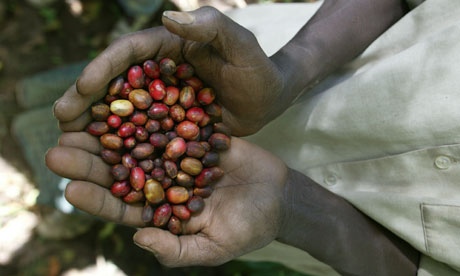 |
| Only an estimated 5% of Ethiopia’s production is wild, what is known locally as forest coffee.' Photograph: Oxfam |
The loss of Ethiopia's wild arabica beans will not spell the end of our daily latte, but exceptional flavours may disappear forever
Last year, when I was on an unsanctioned tour of a coffee warehouse outside Antwerp, a trader confided that several of the world's most important coffee brands were buying beans that were significantly inferior to those they usually purchased. The beans weren't junk – not the kind, as the broker put it, that end up at a truck stop in Poland – but they were a few steps down from the standard buys.It was a shrewd move. Coffee was trading at an all-time high, and the multinational brands knew that consumers were more likely to flip out at a modest price hike than a drop in quality. Switch good beans for passable beans and few will notice, let alone care; keep your standards but raise prices 10c and you'll have customers complaining in the queue and tweeting about it from the counter.
I bring up this observation in response to a study published by researchers at Kew's Royal Botanic Gardens and Ethiopia's Environment and Coffee Forest Forum, which arrives at the disheartening conclusion that some – and possibly all – of the wild arabica coffee growing in Ethiopia, which is considered to be the birthplace of coffee, will be extinct by 2080, a victim of the effects of climate change. (According to the study, the far smaller number of wild coffees found in parts of neighbouring South Sudan and Kenya will follow suit.) But I'm not sure many people will notice.
To be clear, the study doesn't spell out the end of coffee. While it predicts the eradication of wild arabica, the study says little about cultivated arabica, which accounts for nearly all the arabica grown on the planet. (To the journalists who missed or mishandled this basic distinction, it's a good idea to skim a peer-reviewed paper before writing about it.)
It's safe to say that arabica will continue to be planted, harvested, traded, and turned into lattes well past 2080. Agronomists are good at engineering solutions, and if the quality of cultivated coffee suffers as a result, the traders in Antwerp are banking that most of you won't care as long as the price on the menu board holds steady.
What the study details is the likely disappearance of Ethiopia's wild coffees. Chances are, you have never tasted wild coffee. Only an estimated 5% of Ethiopia's production is wild, what is known locally as "forest coffee" (Cultivated plantings in Ethiopia are called "garden coffee"). Willem Boot of Boot Coffee, an expert on Ethiopia, thinks it could be even less, around 1% or 2%.
But that tiny amount accounts for the most diverse sampling of coffee in the world. By one estimate, Ethiopia is home to 98.8% of arabica coffee's gene pool. Most of that diversity is found in the forest.
How many wild coffees are there? It's hard to say – the scholarship doesn't exist. The number some kick around is 1,000, while others think it's higher. These coffees are the stuff of myth. They fire up the imaginations of many leading traders and roasters in the industry's creative class because there's a decent chance that they include some of the world's most spectacular and distinctive coffees. The reasoning goes: if the farmed coffee of Ethiopia is (at its best) that good, just imagine what has yet to be discovered, and what it might taste like if it was processed carefully.
It's not entirely hypothetical. It happened in Panama. In 2002, Daniel Peterson of Hacienda la Esmeralda noted the exceptional quality of the coffee grown on a property his family owned in Jaramillo, outside of the town of Boquete. It turns out the plants were geisha, an Ethiopian variety gathered by a British diplomat in the 1930s and cultivated in Panama in the 1960s.
When the coffee was first sold at auction in 2004, it shattered the record price for coffee (which it set again in 2006, 2007 and 2010). It wasn't because of gimmicks or marketing – nobody knew what geisha was at first – but because of its unusual flavour profile: floral, "bright", "pretty". It redefined what coffee could taste like.
How many strange, delicious coffees are growing wild in Ethiopia? We will never know. Just when we're ready to appreciate the unfamiliar – this generation of tastemakers is fascinated by the peculiar, the mind-blowing – it looks like coffee's most diverse catalogue of flavours will steadily diminish, and probably disappear. The loss of tonnage will be made up elsewhere, but the loss of possibility will be absolute.
http://www.guardian.co.uk

No comments:
Post a Comment